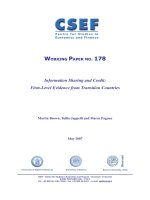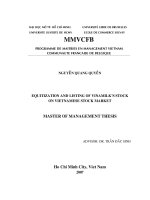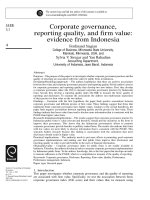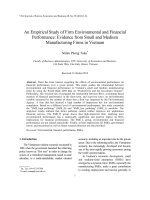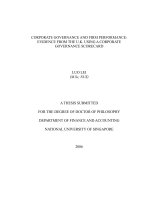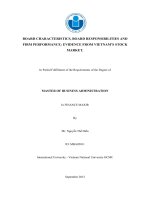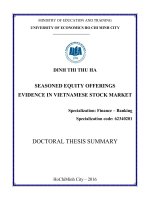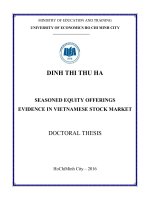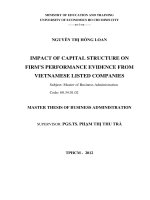Independent directors and firm performance: Evidence from Vietnamese stock market
Bạn đang xem bản rút gọn của tài liệu. Xem và tải ngay bản đầy đủ của tài liệu tại đây (677.32 KB, 11 trang )
Independent directors and firm performance:
Evidence from Vietnamese stock market
Trần Quốc Trung
Đại học Ngoại thương Tp Hồ Chí Minh
Trương Thị Thùy Trang
Đại học Ngoại thương Tp Hồ Chí Minh
Independent directors are the typical mechanism suggested by agency
theory to mitigate the agency problem between a firm’s shareholders and
managers. The extant literature shows that independent directors can
improve corporate operating performance in many developed countries.
In Vietnam, legislations on independent directors are relatively ineffective
and prior studies find debatable results for the effect of independent
directors on firm performance. In this paper, we use 1,003 observations
from 169 firms listed in Ho Chi Minh City Stock Exchange over the period
from 2010 to 2017 to investigate the role of independent directors in
firm profitability. We find that there is a positive association between the
number of independent directors and firm performance. This result implies
Ngày nhận: 09/04/2019
Ngày nhận bản sửa: 07/05/2019
Ngày duyệt đăng: 27/08/2019
Thành viên hội đồng quản trị độc lập và hiệu quả kinh doanh: bằng chứng từ thị trường chứng khoán
Việt Nam
Abstract: Thành viên hội đồng quản trị độc lập là cơ chế điển hình để hạn chế mối quan hệ đại diện giữa người
quản lý và chủ sở hữu công ty. Các nghiên cứu tại các nước phát triển cho thấy các thành viên hội đồng quản
trị độc lập có thể giúp doanh nghiệp cải thiện hiệu quả hoạt động kinh doanh. Ở Việt Nam, các quy định của
pháp luật về sự hiện diện của thành viên hội đồng quản trị độc lập trong công ty đại chúng không phát huy
được tác dụng đáng kể và các nghiên cứu tại Việt Nam cho thấy kết quả không nhất quán về vai trò của thành
viên hội đồng quản trị độc lập đối với hiệu quả hoạt động kinh doanh. Trong bài báo này, chúng tôi sử dụng
1.003 quan sát từ 169 công ty niêm yết tại Sở giao dịch chứng khoán thành phố Hồ Chí Minh để nghiên cứu tác
động của thành viên hội đồng quản trị độc lập đối với lợi nhuận của doanh nghiệp. Chúng tôi thấy rằng có một
mối liên hệ tích cực giữa việc sử dụng thành viên hội đồng quản trị độc lập và hiệu quả kinh doanh. Kết quả
này ngụ ý rằng các công ty niêm yết trên thị trường chứng khoán Việt Nam nên tuân thủ quy định của pháp
luật về sự hiện diện của thành viên hội đồng quản trị độc lập từ đó cải thiện hiệu quả hoạt động kinh doanh.
Keywords: Thành viên hội đồng quản trị độc lập, Lợi nhuận doanh nghiệp, Việt Nam.
Trung Quoc Tran, PhD.
Email: ,
Trang Thi Thuy Truong, M.Ec.
Email: ,
Organization of all: Foreign Trade University, Ho Chi Minh City Campus
Số 207- Tháng 8. 2019- Tạp chí Khoa học & Đào tạo Ngân hàng
13
Independent directors and firm performance: Evidence from Vietnamese stock market
that listed firms in Vietnamese stock market should adhere to the corporate
legislations on independent directors in order to improve their operating
performance.
Key words: Independent directors; Firm profitability; Vietnam.
1. Introduction
The separation of ownership and control
results in agency problem between
shareholders and managers. Firm
managers tend to employ corporate
resources to serve their personal benefits
instead of increasing shareholders’
interest. Therefore, the use of independent
directors is one of the most popular ways
for firms to control agency problem.
Independent directors who do not have
business or personal relations with firm
management can help shareholders
monitor firm managers and supply
firms with professional consulting
service. Many prior studies document
that independent directors are crucial
to improve firm performance. Brickley,
Coles, and Terry (1994); Klein (2002) find
a positive impact of outside directors on
corporate financial performance in the US
market. In addition, supporting evidence
for this relationship is also documented in
other stock markets namely UK (Dahya
& McConnell, 2007; Ezzamel & Watson,
1993), New Zealand (Hossain, Prevost, &
Rao, 2001), China (Liu, Miletkov, Wei,
& Yang, 2015) and Korea (Choi, Park, &
Yoo, 2007; Joh & Jung, 2012).
Vietnam is a young emerging stock
market. Investors’ knowledge and
experience on corporate governance are
relatively little while the enforceability
of legislations on corporate governance
is extremely weak. According to Circular
14
No. 121/2012/TT-BTC issued by the
Ministry of Finance to regulate corporate
governance in public firms, a public firm
shall be obliged to appoint independent
directors so that they account for at least
one third of the board. However, a large
number of firms listed in Vietnam failed
to adhere to this legislation. Recently,
the Government have issued Decree No.
71/2017/ND-CP to boost listed firms
increase the number of independent
directors but there are about 60%
firms without independent directors.
Prior studies conducted in Vietnam
show that the relationship between
board independence and firm operating
performance is mixed.
In this paper, we investigate how
independent directors affect corporate
profitability in Vietnamese stock market
with the following motivations. First,
our study contributes to the literature
on the role of independent directors in
emerging markets. Brickley et al. (1994);
Choi et al. (2007); Hossain et al. (2001);
Klein (2002) show that independent work
effective in developed markets but there
are few studies on this topic in merging
markets that characterized with weak
corporate governance. Second, Vietnam
is an interesting institutional environment
to investigate how independent directors
affect firm profitability due to its
ineffective legislations on corporate
governance in general and independent
directors in particular. Using a research
Tạp chí Khoa học & Đào tạo Ngân hàng- Số 207- Tháng 8. 2019
TRUNG QUOC TRAN - TRANG THI THUY TRUONG
sample of 1,003 observations from 169
firms listed in Ho Chi Minh City Stock
Exchange bewteen 2010 to 2017, we find
that the number of independent directors
is positively related to firm profitabiliy.
This finding implies that despite a poor
corporate governance environment,
independent directors still function
effectively to improve firm profitability.
2. Literature review and hypothesis
development
According to Jensen and Meckling (1976),
although managers are hired to maximize
shareholder’s wealth their interest may not
be aligned due to information asymmetry.
Firm managers have the right to control
corporate resources and thus they tend
to use firm resources for unprofitable
projects which serve their personal
benefits. Therefore, firms need to develop
many mechanisms to monitor and control
managers in order to reduce agency costs.
According to Knyazeva, Knyazeva, and
Masulis (2013), independent directors
play an important role in corporate
governance. First, independent directors
control managers’ behavior to expropriate
shareholders. Schwartz-Ziv and Weisbach
(2013) argue that as a memmer of the
board, independent directors may have
the rights to present their ideas and
suggest approaches to reduce managers’
personal interest in coporate decisions.
They investigate meeting minutes of
the board of directors in US and find
that independent directors are effective
in monitoring managers’ behavior via
board meetings. Weisbach (1988) posits
that independent directors focus mainly
on firm performance since they are
irrelevant to CEO in terms of business or
family connection. Examining the role of
independent directors and CEO turnover
in US, Weisbach (1988) shows that CEO
is more likely to be dismissed due to low
firm profitability or market value when
independent directors constitute over
60% of the board. Second, Kim, Mauldin,
and Patro (2014) argue that independent
directors do not only function as watch
dogs to make sure that managers follow
firms’ benefits but also play the role of
professional consultants in corporate
decisions. Independent directors may be
CEO of other firms, experts in finance,
law, business or former political officials.
They are able to give good advice to
managers or use their relationship with
other parties to support managers’
decisions. Therefore, independent
directors can improve firm performance.
Many prior studies examining the
effects of independent directors on firm
performance are conducted mainly
in developed markets. Brickley et al.
(1994); Klein (2002) investigate the role
of independent directors in US firms and
find that they serve shareholders’ interest.
Dahya and McConnell (2007) analyze
how legislations on independent directors
change corporate performance in the UK
over the period from 1989 to 1996 when
the Cadbury Report calling for at least
three independent directors in the board
came into force. Their research findings
show that firms following this regulation
experience a significant improvement
in their operating outcome both in
absolute values and relative to different
peer group benchmarks. The positive
impact of independent directors on firm
operation performance in the UK is also
documented by Ezzamel and Watson
(1993). Hossain et al. (2001) find that the
positive relationship between independent
Số 207- Tháng 8. 2019- Tạp chí Khoa học & Đào tạo Ngân hàng
15
Independent directors and firm performance: Evidence from Vietnamese stock market
board representation and firm performance
is strong regardless of a change in
legislations on firms and financial
reporting in New Zealand. In Korea, Choi
et al. (2007) investigate how independent
directors affect market value when the
legislation on corporate governance
requiring independent directors was
instituted after the East Asian financial
crisis. They point out that the use of
independent directors positively affects
firm performance. Moreover, Liu et al.
(2015) show robust supporting evidence
for the positive association between
board independence and firm operating
performance in China. Their research
results also indicate that independent
directors are able to control insider
self-dealing and improve investment
efficiency.
In Vietnam, the role of independent
directors in firm performance is a
debatable topic since prior studies show
mixed results. Duc and Thuy (2013)
find no supporting evidence for the
positive impact of board independence
on corporate operating outcome with a
research sample of 77 listed firms during
the period from 2011 to 2016. However,
Vo and Nguyen (2014) show that a
independent directors negatively affect
firm performance of 177 firms listed from
2008 to 2012.
Based on arguments of agency theory
(Jensen & Meckling, 1976), several
prior studies find supporting evidence
that independent directors are able to
control managers’ behavior and increase
firm performance (Brickley et al., 1994;
Choi et al., 2007; Hossain et al., 2001;
Klein, 2002). Therefore, in this paper, we
hypothesize that independent directors
16
may help firms improve their profitability.
H1: The use of dependent directors is
positively related to firm profitability.
3. Research methods
3.1. Research models
To investigate how dependent directors
affects corporate profitability, we
develop a research model in which firm
profitability is a function of the number
of independent directors in the board
and other control variables representing
both corporate governance (i.e. insider
ownership, state ownership, foreign
ownership, board size and CEO duality)
and firm financial characteristics (i.e.
the first lags of firm size, asset growth,
financial leverage, asset tangibility and
firm investment). Since firm profitability
and financial characteristics may affect
each other within a year, we use the first
lags of financial characteristics to mitigate
this endogeneity problem.
Roat = α + β1N_indt + β2Ins_ownt +
β3Sta_ownt + β4For_ownt + β5Bod_sizt +
β6Ceo_duat + β7Siz_mct-1 + β8Ass_grot-1 +
β9Fin_levt-1 + β10Ass_tant-1 + β11Inv_capt-1
+ γIndustry dummies + ε (1)
Where Roat is return on assets in year
t. N_indt is the number of independent
directors in the board. In addition, we
also use the proportion of independent
directors in the board (P_indt) and a
dummy assigned 1 if firms have at least
one independent director and 0 otherwise
(D_indt) as robustness checks. Ins_ownt is
insider ownership. According to agency
theory (Jensen & Meckling, 1976),
managers are more likely to use firm
Tạp chí Khoa học & Đào tạo Ngân hàng- Số 207- Tháng 8. 2019
TRUNG QUOC TRAN - TRANG THI THUY TRUONG
resources to serve their own interest.
However, if they hold more shares, their
appropriation of shareholders is lower and
thus firm profitability is higher. Sta_ownt
is state ownership in year t. Chen, Jian,
and Xu (2009) posit that state shareholders
tend to follow political objectives rather
than economic efficiency. On the other
hand, firms with more state ownership
may receive more favorable treatment
from the government (e.g. better access to
credit or lower tax rates) (Szamosszegi &
Kyle, 2011). Therefore, state ownership
also affects firm profitability. For_ownt is
foreign ownership in year t. Most foreign
investors in Vietnamese stock market
are foreign institutions that may have
good corporate governance experience
(Loncan, 2018). Therefore, we posit
that foreign ownership positvely affect
firm profitability. Bod_sizet is board
size in year t. Board size may affect firm
Variables
Roa
N_ind
P_ind
D_ind
profitability in two opposite channels. On
the one hand, a larger board may monitor
managers more effectively and improve
firm profitability (Adams & Ferreira,
2007). On the other hand, firms with larger
boards face more difficulties in board
members’ coordination and consensus
that negatively affect firms’ economic
efficiency. Ceo_duat is CEO duality
in year t. CEO duality leads to severe
agency problem which in turn reduce
firm profitability (Yang & Zhao, 2014).
Siz_mct-1 is firm size in year t-1. Ass_grotis asset growth in year t-1. Fin_levt-1 is
1
financial leverage in year t-1. Ass_tant-1 is
asset tangibility in year t-1. According to
pecking order theory suggested by Myers
and Majluf (1984), firms with larger
size, higher asset growth, lower financial
leverage are more likely to obtain external
funds with lower costs. Therefore, they
may have higher profitability. Inv_capt-
Table 1. Definitions of main variables
Variable names
Mean
Return on assets
Net income scaled by total assets
Number of independent
directors
Proportion of
independent directors
Dummy for the presence
of independent directors
Number of independent directors in the board
Proportion of independent directors in the board
Assigned 1 if firms have at least one independent director
and 0 otherwise
Ins_own
Insider ownership
Proportion of shares held by insiders
Sta_own
State ownership
Proportion of shares held by state agencies
For_own
Foreign ownership
Proportion of shares held by foreign institutions and
individuals
Bod_siz
Board size
Total number of directors in the board
Ceo_dua
CEO duality
1 if CEO is also the chairman, 0 otherwise
Siz_mc
Firm size
Natural logarithm of market capitalization
Ass_gro
Asset growth
Annual growth rate of total assets
Fin_lev
Financial leverage
Total debt scaled by total assets
Ass_tan
Asset tangibility
Fixed assets scaled by total assets
Inv_cap
Investment
Capital expenditure scaled by total assets
Số 207- Tháng 8. 2019- Tạp chí Khoa học & Đào tạo Ngân hàng
17
Independent directors and firm performance: Evidence from Vietnamese stock market
A. Annual number of firms
Table 2. Description of research sample
Year
N
Percent
Year
N
Percent
2010
59
5.88
2014
139
13.86
2011
97
9.67
2015
143
14.26
2012
118
11.76
2016
155
15.45
2013
128
12.76
2017
164
16.35
B. Industry distribution
Industry
N
Percent
Industry
N
Percent
Technology
23
2.3
Health Care
45
4.5
Industrials
364
36.3
Consumer Goods
255
25.4
Oil & Gas
8
0.8
Basic Materials
152
15.2
Consumer Services
61
6.1
Utilities
95
9.5
N
Mean
S.D.
Min
Max
Roat
1,003
0.07
0.06
-0.04
0.24
N_indt
1,003
0.82
1.22
0.00
5.00
Ins_ownt
1,003
0.11
0.16
0.00
0.65
Sta_ownt
1,003
0.23
0.24
0.00
0.70
For_ownt
1,003
0.13
0.15
0.00
0.65
Bod_sizt
1,003
5.76
1.26
3.00
11.00
Ceo_duat
1,003
26.81
1.34
24.70
30.04
Siz_mct-1
1,003
0.04
0.19
0.00
1.00
Ass_grot-1
1,003
0.13
0.22
-0.21
0.77
Fin_levt-1
1,003
0.48
0.21
0.09
0.83
Ass_tant-1
1,003
0.22
0.18
0.01
0.68
Inv_capt-1
1,003
0.03
0.02
0.00
0.09
C. Descriptive statistics
Variables
Roat is return on assets in year t. Nindt is the number of independent directors in the board. P_indt is the
proportion of independent directors in the board. D_indt is a dummy assigned 1 if firms have at least one
independent director and 0 otherwise. Ins_ownt is insider ownership. Sta_ownt is state ownership in year t.
For_ownt is foreign ownership in year t. Bod_sizet is board size in year t. Ceo_duat is CEO duality in year
t. Siz_mct-1 is firm size in year t-1. Ass_grot-1 is asset growth in year t-1. Fin_levt-1 is financial leverage in
year t-1. Ass_tant-1 is asset tangibility in year t-1. Inv_capt-1 is corporate investment in year t-1
is corporate investment in year t-1.
Firms with more investment should have
higher profitability (Goddard, Tavakoli, &
Wilson, 2005). Definitions of these main
research variables are reported in Table 1.
1
18
3.2. Data collection
To establish the research sample, we
choose all non-financial firms listed in
Ho Chi Minh Stock Exchange. Financial
Tạp chí Khoa học & Đào tạo Ngân hàng- Số 207- Tháng 8. 2019
-0.06*
0.07
0.00
0.62
0.00
0.25***
0.02
0.26
0.00
0.14***
-0.04
0.59
0.13
-0.46***
-0.02
0.65
0.17
0.05
-0.01
0.72
0.00
-0.04
0.01
0.00
0.49
0.30***
0.17***
0.27
0.02
0.00
0.03
0.00
0.00
0.25***
-0.14***
0.01
0.01
0.16***
0.08**
-0.08***
0.11
0.05
N_indt
0.00
-0.10***
0.00
-0.10***
0.02
0.08**
0.37
0.03
0.21
0.04
0.00
-0.13***
0.80
-0.01
0.00
-0.09***
0.00
-0.25***
Ins_ownt
0.00
0.23***
0.00
0.18***
0.65
-0.01
0.00
-0.18***
0.16
-0.04
0.81
0.01
0.00
-0.22***
0.00
-0.20***
Sta_ownt
0.26
0.04
0.55
0.02
0.00
-0.14***
0.00
0.12***
0.11
-0.05
0.00
0.47***
0.00
0.35***
For_ownt
0.01
-0.09***
0.39
-0.03
0.41
0.03
0.00
0.11***
0.08
-0.06*
0.00
0.24***
Bod_sizt
0.00
0.12***
0.00
0.12***
0.00
-0.10***
0.00
0.21***
0.07
-0.06*
0.83
0.01
0.75
-0.01
0.83
-0.01
0.20
0.04
0.00
0.00
0.00
0.00
-0.12*** -0.12*** 0.66***
0.00
-0.19*** -0.11***
0.00
0.13***
Ceo_duat Siz_mc Ass_gro Fin_lev Ass_tan
Roat is return on assets in year t. N_indt is the number of independent directors in the board. Ins_ownt is insider ownership. Sta_ownt is state ownership in
year t. For_ownt is foreign ownership in year t. Bod_sizet is board size in year t. Ceo_duat is CEO duality in year t. Siz_mct-1 is firm size in year t-1. Ass_grotis asset growth in year t-1. Fin_levt-1 is financial leverage in year t-1. Ass_tant-1 is asset tangibility in year t-1. Inv_capt-1 is corporate investment in year t-1.
1
t-statistics are in parentheses. * is significant at 10%. ** is significant at 5%. *** is significant at 1%
Inv_capt-1
Ass_tant-1
Fin_levt-1
Ass_grot-1
Siz_mct-1
Ceo_duat
Bod_sizt
For_ownt
Sta_ownt
Ins_ownt
N_indt
Roat
Table 3. Correlation matrix
TRUNG QUOC TRAN - TRANG THI THUY TRUONG
Số 207- Tháng 8. 2019- Tạp chí Khoa học & Đào tạo Ngân hàng
19
Independent directors and firm performance: Evidence from Vietnamese stock market
information and ownership structure
are provided by Stoxplus. Number of
independent directors, board size and
CEO duality are hand collected from
annual reports from 2010 to 2017. After
eliminating observations with incomplete
information, we have a final research data
including 1,003 observations from 169
firms. In addition, financial variables are
winsoried at 3% to mitigate effects of
outliers.
Panel A of Table 2 shows that the
number of firms included in the research
sample increases considerably from
2010 to 2017. The year 2010 accounts
for the smallest percentage of firms
with 5.88% and the year 2017 constitute
the highest proportion with 16.35%.
Panel B shows the distribution by
industry classified in accordance with
the Industry Classification Benchmark
(ICB). The number of observations varies
significantly across industries. Industrials
is the largest with 36.3%, followed by
Consumer Goods (25.4%) and Basic
Materials is the third with 15.2%. On the
other hand, Oil & Gas only contributes 8
firm-years with 0.8% and Technology is
2.3%.
4. Research findings
Panel C of Table 2 presents descriptive
statistics of main research variables.
Return on assets of firms in the research
sample varies considerably from -4%
to 24% and its mean is 7%. During the
research period form 2010 to 2017,
Vietnamese economy started to recover
and developed significantly; therefore,
firm profitability are less likely to
be negative. The largest number of
independent directors in a firm is 5 while
20
there are many firms without independent
directors. This partly reflects ineffective
legislations that forces listed firms to
increase their board independence.
Insider ownership and foreign ownership
ranges from 0 to 65% with mean values
of 11% and 13% respectively. State
ownership is higher with 23% of shares
on average. In addition, board size is
from 3 to 11 directors and there are
26.81% of observations with CEO duality.
Furthermore, the descriptive statistics
of financial variables show that they are
appropriate for subsequent regression
analysis.
Table 3 shows the correlation matrix of
research variables. Firm profitability has
Table 4. Checking for multicollinearity
Variables
VIF
1/VIF
N_indt
1.06
0.95
Ins_ownt
1.1
0.91
Sta_ownt
1.26
0.79
For_ownt
1.48
0.68
Bod_sizt
1.24
0.81
Ceo_duat
1.01
0.99
Siz_mct-1
1.41
0.71
Ass_grot-1
1.15
0.87
Fin_levt-1
1.07
0.94
Ass_tant-1
1.85
0.54
Inv_capt-1
1.87
0.53
Mean VIF
1.32
N_indt is the number of independent directors in
the board. Ins_ownt is insider ownership. Sta_ownt
is state ownership in year t. For_ownt is foreign
ownership in year t. Bod_sizet is board size in year
t. Ceo_duat is CEO duality in year t. Siz_mct-1 is
firm size in year t-1. Ass_grot-1 is asset growth in
year t-1. Fin_levt-1 is financial leverage in year t-1.
Ass_tant-1 is asset tangibility in year t-1. Inv_capt-1
is corporate investment in year t-1
Tạp chí Khoa học & Đào tạo Ngân hàng- Số 207- Tháng 8. 2019
TRUNG QUOC TRAN - TRANG THI THUY TRUONG
Table 5. Regression results
Variables
N_indt
Model 1
Model 2
Model 3
0.0038***
(2.69)
P_indt
0.0166**
(2.02)
D_indt
0.0091***
(2.62)
Ins_ownt
Sta_ownt
For_ownt
Bod_sizt
Ceo_duat
Siz_mct-1
Ass_grot-1
Fin_levt-1
Ass_tant-1
Inv_capt-1
Intercept
0.0011
0.0013
0.0015
(0.10)
(0.12)
(0.14)
0.0499***
0.0491***
0.0495***
(6.21)
(6.10)
(6.17)
0.0480***
0.0473***
0.0484***
(3.57)
(3.52)
(3.60)
-0.0019
-0.0014
-0.0015
(-1.33)
(-0.98)
(-1.04)
-0.0106
-0.0108
-0.0107
(-1.22)
(-1.24)
(-1.23)
0.0088***
0.0088***
0.0085***
(5.74)
(5.73)
(5.55)
0.0251***
0.0249***
0.0248***
(3.17)
(3.13)
(3.12)
-0.1256*** -0.1257*** -0.1258***
(-15.33)
(-15.29)
(-15.35)
-0.0198
-0.0191
-0.0173
(-1.51)
(-1.46)
(-1.32)
0.5630***
0.5599***
0.5563***
(5.75)
(5.71)
(5.69)
-0.1499*** -0.1515*** -0.1463***
(-3.50)
(-3.52)
(-3.41)
Industry
dummies
Yes
Yes
Yes
R-squared
0.37
0.37
0.37
F-statistics
32.06***
31.78***
32.02***
Number of
1,003
1,003
1,003
observations
Roat is return on assets in year t. N_indt is the
number of independent directors in the board.
P_indt is the proportion of independent directors
in the board. D_indt is a dummy assigned 1 if
firms have at least one independent director and 0
otherwise. Ins_ownt is insider ownership. Sta_ownt
is state ownership in year t. For_ownt is foreign
ownership in year t. Bod_sizet is board size in year
t. Ceo_duat is CEO duality in year t. Siz_mct-1 is
firm size in year t-1. Ass_grot-1 is asset growth in
year t-1. Fin_levt-1 is financial leverage in year t-1.
Ass_tant-1 is asset tangibility in year t-1. Inv_captis corporate investment in year t-1. t-statistics
1
are in parentheses. * is significant at 10%. ** is
significant at 5%. *** is significant at 1%
positive correlations with state ownership,
foreign ownership, CEO duality, asset
tangibility and corporate investment
and negative correlations with insider
ownership and firm leverage. Remarkably,
all correlation coefficients are smaller
than 0.5. In addtion, Table 4 presents
values of variance inflation factor (VIF)
to check for multicolinearity. As a rule
of thumb, a variable whose VIF values
are greater than 10 may merit further
investigation. Tolerance (1/VIF) is used
by many researchers to check on the
degree of collinearity. A tolerance value
smaller than 0.1 is equivalent to a VIF of
10 (Baltagi, 2008; Wooldridge, 2010).
These findings indicate the there is no
multicollinearity between explanatory
variables.
Table 5 reports pooled OLS regression
results to analyze how independent
directors affect firm profitability measured
by return on assets. While Model 1
show estimation results for Equation
(1), Model 2 and Model 3 are those with
alternative measures including proportion
of independent directors in the board and
a dummy variable to proxy the presence
of independent directors for robustness
checks. We find that all measures of
independent director appointment are
positively related to firm profitability.
Số 207- Tháng 8. 2019- Tạp chí Khoa học & Đào tạo Ngân hàng
21
Independent directors and firm performance: Evidence from Vietnamese stock market
These findings are consistent with
many prior studies in US (Brickley et
al., 1994; Klein, 2002), UK (Dahya &
McConnell, 2007; Ezzamel & Watson,
1993), New Zealand (Hossain et al.,
2001), Korea (Choi et al., 2007; Joh &
Jung, 2012) and China (Liu et al., 2015).
Independent directors may monitor
managers’ decisions and provide firms
advice with their professional knowledge
and experience; therefore, they help
firms improve operating performance.
State ownership and foreign ownership
also have positive effects on firm
performance. These can be explained
that firms with higher state ownership
and foreign ownership receive more
favorable treatment from the government
and incur lower agency costs due to
stricter monitoring from foreign investors
respectively; consequently, they have
better performance.
Moreover, our research findings show that
firm size and asset growth are positively
associated with return on assets at the
significant level of 1%. Larger firms have
better reputation which leads to lower
costs of external financing and firms
with higher asset growth rate have more
investment opportunities (Fama & French,
2001). Hence, their business is more
efficient. Besides, we find that financial
leverage and corporate investment are
negatively and positively related to firm
profitability. These imply that firms with
higher leverage are more financially
constrained and they incur higher costs
of external financing. Firms with more
investment generate more profits.
5. Conclusions, implications and
limitations
Independent directors are one of the
most popular approaches to mitigate the
agency problem between firm managers
and owners. The extant literature shows
that independent directors can improve
corporate operating performance in
many developed countries. In Vietnam,
legislations on the presence of independent
directors are relatively ineffective and
prior studies find debatable results for
the effect of independent directors on
firm performance. In this paper, we use
1,003 observations from 169 firms listed
in Ho Chi Minh City Stock Exchange
to investigate the role of independent
directors in firm profitability. We find that
there is a positive association between
the use of independent directors and firm
performance. This result implies that
listed firms in Vietnamese stock market
should adhere to the corporate legislations
on independent directors in order to
improve their operating performance. This
study has two main limitations including
regression method and sample size.
The pooled OLS model is not a strong
econometric technique due to its weak
assumptions (Baltagi, 2008; Wooldridge,
2010). Besides, our small sample size also
negatively affects the reliability of our
research findings ■
Tài liệu tham khảo
1. Adams, R. B., & Ferreira, D. (2007). A theory of friendly boards. The Journal of Finance, 62(1), 217-250.
2. Baltagi, B. (2008). Econometric analysis of panel data: John Wiley & Sons.
3. Brickley, J. A., Coles, J. L., & Terry, R. L. (1994). Outside directors and the adoption of poison pills. Journal of
Financial Economics, 35(3), 371-390. doi: />4. Chen, D., Jian, M., & Xu, M. (2009). Dividends for tunneling in a regulated economy: The case of China. Pacific-
22
Tạp chí Khoa học & Đào tạo Ngân hàng- Số 207- Tháng 8. 2019
TRUNG QUOC TRAN - TRANG THI THUY TRUONG
Basin Finance Journal, 17(2), 209-223. doi: />5. Choi, J. J., Park, S. W., & Yoo, S. S. (2007). The value of outside directors: Evidence from corporate governance
reform in Korea. Journal of Financial Quantitative Analysis, 42(4), 941-962.
6. Dahya, J., & McConnell, J. (2007). Board composition, corporate performance, and the Cadbury committee
recommendation. Journal of Financial Quantitative Analysis, 42(3), 535-564.
7. Duc, V. H., & Thuy, P. B. G. (2013). Corporate governance and firm’s performance: empirical evidence from
Vietnam. Journal of Economic Development(JED, No. 218), 62-77.
8. Ezzamel, M., & Watson, R. (1993). Organizational Form, Ownership Structure and Corporate Performance: A
Contextual Empirical Analysis of UK Companies 1. British Journal of Management, 4(3), 161-176.
9. Fama, E. F., & French, K. R. (2001). Disappearing dividends: changing firm characteristics or lower propensity to
pay? Journal of Financial Economics, 60(1), 3-43. doi: />10.Goddard, J., Tavakoli, M., & Wilson, J. O. S. (2005). Determinants of profitability in European manufacturing
and services: evidence from a dynamic panel model. Applied Financial Economics, 15(18), 1269-1282.
doi:10.1080/09603100500387139
11.Hossain, M., Prevost, A. K., & Rao, R. P. (2001). Corporate governance in New Zealand: The effect of the 1993
Companies Act on the relation between board composition and firm performance. Pacific-Basin Finance Journal, 9(2),
119-145. doi: />12.Jensen, M. C., & Meckling, W. H. (1976). Theory of the firm: Managerial behavior, agency costs and ownership
structure. Journal of Financial Economics, 3(4), 305-360. doi: />13.Joh, S. W., & Jung, J. Y. (2012). The effects of outside board on firm value in the emerging market from the
perspective of information transaction costs. Asia-Pacific Journal of Financial Studies, 41(2), 175-193.
14.Kim, K., Mauldin, E., & Patro, S. (2014). Outside directors and board advising and monitoring performance.
Journal of Accounting and Economics, 57(2–3), 110-131. doi: />15.Klein, A. (2002). Audit committee, board of director characteristics, and earnings management. Journal of
Accounting and Economics, 33(3), 375-400. doi: />16.Knyazeva, A., Knyazeva, D., & Masulis, R. W. (2013). The supply of corporate directors and board independence.
The Review of Financial Studies, 26(6), 1561-1605.
17.Liu, Y., Miletkov, M. K., Wei, Z., & Yang, T. (2015). Board independence and firm performance in China. Journal
of Corporate Finance, 30, 223-244.
18.Loncan, T. (2018). Foreign institutional ownership and corporate cash holdings: Evidence from emerging
economies. International Review of Financial Analysis. doi: />19.Myers, S. C., & Majluf, N. S. (1984). Corporate financing and investment decisions when firms have information
that investors do not have. Journal of Financial Economics, 13(2), 187-221. doi: />20.Schwartz-Ziv, M., & Weisbach, M. S. (2013). What do boards really do? Evidence from minutes of board meetings.
Journal of Financial Economics, 108(2), 349-366. doi: />21.Szamosszegi, A., & Kyle, C. (2011). An analysis of state-owned enterprises and state capitalism in China (Vol. 52):
Capital Trade, Incorporated for US-China Economic and Security Review Commission.
22.Vo, D. H., & Nguyen, T. M. (2014). The impact of corporate governance on firm performance: Empirical study in
Vietnam. International journal of economics and finance, 6(6), 1-13.
23.Weisbach, M. S. (1988). Outside directors and CEO turnover. Journal of Financial Economics, 20(C), 431-460.
24.Wooldridge, J. M. (2010). Econometric Analysis of Cross Section and Panel Data (10th ed.). Cambridge: MIT
Press.
25.Yang, T., & Zhao, S. (2014). CEO duality and firm performance: Evidence from an exogenous shock to
the competitive environment. Journal of Banking & Finance, 49, 534-552. doi: />jbankfin.2014.04.008
Số 207- Tháng 8. 2019- Tạp chí Khoa học & Đào tạo Ngân hàng
23
